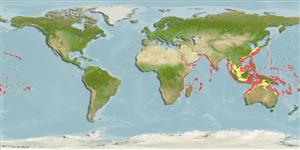>
Eupercaria/misc (Various families in series Eupercaria) >
Lutjanidae (Snappers) > Etelinae
Etymology: Pristipomoides: Greek, pristis = saw + Greek, poma, -atos = cover, operculum + Greek, oides = similar to (Ref. 45335).
More on author: Valenciennes.
Environment: milieu / climate zone / depth range / distribution range
Οικολογία
Θαλασσινό(ά) βενθοπελαγικό; εύρος βάθους 40 - 400 m (Ref. 11888), usually 180 - 270 m (Ref. 9821). Deep-water; 35°N - 26°S, 31°E - 144°W (Ref. 55)
Indo-Pacific: East Africa to Hawaii and Tahiti, north to southern Japan, south to eastern Australia and Lord Howe Island.
Length at first maturity / Μέγεθος / Βάρος / Age
Maturity: Lm 52.0, range 37 - ? cm
Max length : 100.0 cm TL αρσενικό/απροσδιόριστο; (Ref. 5484); common length : 50.0 cm SL αρσενικό/απροσδιόριστο; (Ref. 9821); μεγ. δημοσιευμένο βάρος: 8.2 kg (Ref. 4887); μεγ. αναφερόμενη ηλικία: 44 έτη (Ref. 92301)
Ραχιαίες άκανθες (συνολικά) : 10; Μαλακές ραχιαίες ακτίνες (συνολικά) : 11; Εδρικές άκανθες: 3; Μαλακές εδρικές ακτίνες: 8. This species is distinguished by the following characters: body elongate, laterally compressed; jaws about equal or lower jaw protruding slightly; premaxillae protrusible. maxilla extending to vertical through about anterior margin of pupil; upper and lower jaws both with an outer row of conical to small canine teeth and an inner band of villiform teeth, the caniniform teeth at anterior ends of jaws are not appreciably enlarged; teeth on vomer triangular patch, maxilla without scales or longitudinal ridges; interorbital region flattened. Gill rakers on first gill arch 7-8 + 15-18 = 22-26; last soft ray of both dorsal and anal fins well
produced, longer than next to last ray; caudal fin forked; pectoral fins long, about equal to or somewhat shorter than head length; membranes of dorsal and anal fins without scales; tubed
lateral-line scales 57-62. Colour variable, ranging from brownish to lavender or reddish
purple; snout and interorbital space with narrow yellow lines and blue spots often persisting as dark spots when preserved; dorsal and caudal fins light blue or lavender with reddish orange margins (Ref. 9821).
Adults occur over rocky bottoms (Ref. 30573); off Guam, caught most abundantly between 180 and 270 m (Ref. 9821). At night, they migrate vertically to the upper part of its habitat to feed (Ref. 11888). They feed on small fishes, shrimps, crabs, amphipods, ascidians and salps. Marketed fresh (Ref. 55). Caught mainly with bottom longlines and deep handlines, marketed main fresh and a good quality food fish (Ref. 9821).
Allen, G.R., 1985. FAO Species Catalogue. Vol. 6. Snappers of the world. An annotated and illustrated catalogue of lutjanid species known to date. FAO Fish. Synop. 125(6):208 p. Rome: FAO. (Ref. 55)
IUCN Red List Status (Ref. 130435: Version 2024-1)
Threat to humans
Harmless
Human uses
αλιεία: πολύ εμπορικό; αλιεία αναψυχής: ναί
Εργαλεία
Special reports
Download XML
Διαδικτυακές πηγές
Estimates based on models
Preferred temperature (Ref.
123201): 12.2 - 22.6, mean 15 °C (based on 199 cells).
Phylogenetic diversity index (Ref.
82804): PD
50 = 0.5005 [Uniqueness, from 0.5 = low to 2.0 = high].
Bayesian length-weight: a=0.01072 (0.00752 - 0.01527), b=2.93 (2.83 - 3.03), in cm total length, based on LWR estimates for this species (Ref.
93245).
Τροφικό Επίπεδο (Ref.
69278): 4.2 ±0.4 se; based on diet studies.
Generation time: 4.4 (3.5 - 10.0) years. Estimated as median ln(3)/K based on 14
growth studies.
Ελαστικότητα (Ref.
120179): Μεσαίο(α), ελάχιστος χρόνος για διπλασιασμό πληθυσμού 1,4 - 4,4 έτη (K=0.16-0.31; tmax=18).
Prior r = 0.58, 95% CL = 0.39 - 0.88, Based on 1 full stock assessment.
Fishing Vulnerability (Ref.
59153): Moderate vulnerability (43 of 100).
Climate Vulnerability (Ref.
125649): High to very high vulnerability (75 of 100).
Nutrients (Ref.
124155): Calcium = 12.9 [6.3, 32.6] mg/100g; Iron = 0.303 [0.131, 0.673] mg/100g; Protein = 16.9 [14.9, 18.7] %; Omega3 = 0.221 [0.100, 0.484] g/100g; Selenium = 23.1 [9.1, 58.0] μg/100g; VitaminA = 16.3 [3.2, 89.0] μg/100g; Zinc = 0.299 [0.191, 0.484] mg/100g (wet weight);
